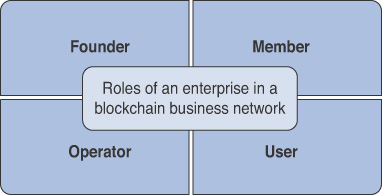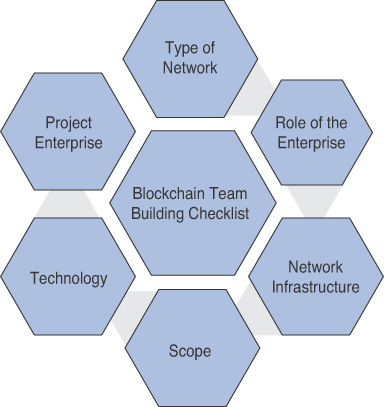6
Building a Team to Drive Blockchain Projects
In an ecosystem, distributed teams that are committed to achieving a common business goal thrive and succeed.
—Jai Singh Arun
In a nutshell, blockchain democratizes decision making by using a decentralized economic structure, which enables enormous opportunities for innovation and agility with autonomy, motivation, and creativity in distributed teams across the ecosystem. Blockchain promises to transform industries by inspiring new business models, ecosystems, governance, and organizational structures. These business elements depend heavily on each other’s strengths, however, and the success of a blockchain network is entirely an outcome of their performance. Therefore, choosing the correct use case, defining the correct business model and governance, and building the correct team is the formula for the success of a blockchain network.
As part of creating a decentralized organizational structure, business leaders must define a minimal viable ecosystem (MVE) and minimal viable product (MVP) concept. They must then identify the key roles and responsibilities of distributed teams across multiple enterprises that work toward common business goals. This approach is referred to as an intraprise synergy.
Enterprise Structures in a Decentralized Economy
Many modern organizations in the current economic structure strive to achieve monopolistic profit gains. In doing so, they may create competition that inadvertently nurtures intermediaries that drive higher costs and lower the quality of goods and services that are offered to the consumers. Conversely, a decentralized economy challenges the status quo with a new paradigm of peer-to-peer exchange and shared gains. This new shift might not be applicable to all enterprises that are adopting blockchain technology in their business use cases and industry processes, so you must choose a right organizational structure from among the choices of centralized, decentralized, and hybrid economies.
Centralized Structure
In a centralized structure, enterprises work toward concentrating the power and authority of the business network and the legal policies, procedures, and operations. The communication and decision-making power traverse in a top-down direction. This approach is a good choice for making faster decisions and executing business transaction validation and commits in the ledgers, but it might not enhance collaboration, innovation, and efficiency in the network.
The primary roles in enterprises within a centralized structure are hierarchical, and responsibilities are divided in a way that produces an inflexible environment for co-development and limits motivation. The business execution logic in these enterprises is tightly coupled and controlled to ensure the stability of the system, which leaves the system vulnerable to a single point of failure.
Among the most popular centralized structure-based enterprises today are Google and Facebook. In these organizations’ operations, all Internet transactions are directed toward a centralized system or platform.
Decentralized Structure
In a decentralized structure, authority and control are distributed across the enterprises that participate in the blockchain business network (Figure 6.1). The business functions are loosely coupled so that execution can be faster, but making a unified decision or achieving consensus might become a time-consuming activity. Creating an environment conducive to co-developing and sharing the gains is the primary intent of decentralized structures.

Unlike a centralized system, a decentralized system does not require all the transactions to pass through a single platform. Instead, many nodes in the system can perform peer-to-peer actions. BitTorrent is a typical example of a decentralized structure where a peer-to-peer file sharing protocol is used to distribute data and electronic files over the Internet.
Hybrid Structure
The hybrid structure is the most suitable environment for many enterprises that want to leverage the value of blockchain from an autonomy perspective, but also need to maintain authority and control over certain aspects of the platform and network. With such a structure, no central entity reviews and validates business transactions within the network. Instead, the blockchain network consists of enterprises that have either a centralized or decentralized structure. Many of the blockchain consortia today employ a hybrid structure in which the decentralization of transactional information provides speed, transparency, and auditability, but can also provide high throughput.
Roles of an Enterprise in a Blockchain Network
Major industries are regulated in terms of business transactions and data privacy compliance requirements. The enterprises within these industries cannot adopt a public blockchain network. Instead, private or permissioned blockchain networks are the preferred choices for enterprises that can balance their business needs with their needs for technology innovation, and for regulation and compliance.
When a private or permissioned blockchain network is established to transform an industry business process, enterprises may play various roles depending on their business goals and network value outcomes (Figure 6.2). For example, these roles might include those of a founder, member, operator, or general user of a network or consortium. In addition, some of the roles can be combined or further disjoined in a network based on the stage, maturity, scale, industry, business process, and use case.

Founders
Founder enterprises have identified a business transformation or disruptive use case or process. They have a clear vision for the blockchain network, its participants, business benefits, and costs, and how it can be designed, built, operated, managed, and governed. Founders assume the responsibility of inviting the appropriate participating enterprises and sharing the vision and business value of the network to encourage participation.
Pragmatically, it is best if a consortium has only one or very few founders, so as to assure better control and management. However, this setup defeats the purpose of decentralization in the network—that is, the autonomy of the other participants.
Hundreds of blockchain consortia have been built over the past few years. R3 is an example of a founder of a consortium that includes more than 200 financial institutes, regulators, banks, and other enterprises.
Members
Member enterprises are members of a blockchain network along with the founding enterprises. They might have joined the network either as a founding member or after the network is established. Member enterprises have a blockchain node that is called a peer, which means they have a copy of the ledger and can run chaincode and participate in the consensus process if they are authorized by founders or other governing enterprises, based on consortium policies and rules. Members share the costs and benefits of network design, construction, and deployment. As the network grows and the members’ contributions, roles, and responsibilities change, they can become founding enterprises.
Financial institutes such as JPMC, Credit Suisse, RBS, and UBS are members of the R3 consortium.
Operators
The operator of a blockchain network can be a founder or member enterprise. Alternatively, it can be a third-party enterprise that assumes responsibility for the network operations and technology management for a fee that is based on the transactions volume or a fixed monthly or annual fee. If the operator is not a member or founder, then it might not be given access and visibility to the business transactions in the network. It might have a copy of a distributed ledger, but only for performing operating tasks. The operator enterprise maintains service level agreements (SLAs) regarding the operations quality, and the performance and availability of the network.
Users
The users of a blockchain network are invited and enabled by the founders and members. Depending on the users’ permission level, they can access or view part of the transactions and network information, but they do not own data. For example, regulators and auditors may become users of a network so that they can view network transactions and ensure that compliance guidelines are met.
Users might pay a fee for network access and participation based on an agreed plan with the network founder and members. As general users continue to contribute and bring value to network, they may become members per the governance policies and guidelines.
Building an Effective Team
To build an effective team for a blockchain project and business network, you must ensure that the following items are identified and defined (Figure 6.3):
Project enterprise: Is your organization a start-up enterprise that is building a new business solution or network by using blockchain, or is it part of an existing enterprise that has identified an industry process or business use case for blockchain?
Type of a network: Will the blockchain network be led by the founder enterprise(s) or by consortium members?
Roles of participating enterprises in the network: Are the enterprises founders, members, operators, or users?
Technology: Will the network use enterprise-ready blockchain technologies like Hyperledger or Ethereum, or will the founder build its own?
Network infrastructure: Will the network use cloud environments that are provided by major vendors, or will your enterprise build its own private cloud or on-premises infrastructure?
Scope: Do you have MVP and MVE requirements and limits?

The answers to these questions can help you identify the requirements for the key network activities, roles, responsibilities, and corresponding team members and skills.
Project Team Roles
A typical blockchain project team requires all or some of the key roles described in this section. Some of these roles may be combined depending on the project enterprise, type of network, roles of participating enterprises, technology, and network infrastructure.
Steering Committee Members
Steering committee members are individuals from enterprises that are part of the network. They direct the management and governance of the overall blockchain network, business and legal policies, rules, and regulations.
Legal Consultants
Legal counsel is crucial in the blockchain project and network. Legal consultants provide advice about how legal partnerships and contracts are defined for the automated execution of smart contracts and how to structure initial coin offerings (ICOs) from a compliance regulation perspective.
Blockchain Consultants
Blockchain consultants help businesses adopt blockchain technology and build the network of organizations by using blockchain applications and solutions. Consultants must understand the principles of blockchain technology, the systems, and applications.
Crypto Developer
A crypto developer defines and develops the level of security and encryption strength required for transactions and network security.
Project Managers
Project managers manage the entire blockchain project life cycle, including schedules, costs, and budget. They control and oversee work items and process activities, and define tasks and deliverables for other roles.
Product Owners
Product owners manage the overall vision—that is, the roadmap for the development and delivery of the product, features, and functions based on the business requirements of the blockchain network. They also are responsible for the profit and loss of the product.
User Researchers
User researchers identify a problem or pain point for a user in the context of an industry or business use case transformation. In addition, they develop the user requirements and user behaviors related to the blockchain network.
User Experience Designers
User experience (UX) designers write user stories. They enable a seamless experience for users by specifying simplified interfaces and information that is presented from the blockchain system and network.
Blockchain Architect
The blockchain architect defines the system architecture, including how the nodes (computers) are deployed in a blockchain network and how everyone agrees by consensus whether the transactions are valid.
System Architect
The system architect defines how the system operates in a blockchain network by incorporating input from the blockchain architect, designer, product owner, and developers.
Blockchain Developers
Blockchain developers program the logic of business networks into chaincode and application user interfaces. These developers should be proficient in JavaScript or have golang (Go programming language) programming skills.
Quality or Test Engineer
Quality or test engineers evaluate each function, feature, application, and overall blockchain system by using various input parameters and conditions to identify any defects. The goal is for the developer to fix these defects before the product is put into a production environment.
Network Engineer
Network engineers ensure that peer-to-peer networking works at scale in a blockchain. They make sure that data and information are communicated or exchanged efficiently to the intended recipient only.
Business Development Manager
The business development manager’s task is to forge business partnerships across the ecosystem, with or without participation of those enterprises in a blockchain network. The manager also develops sales proposals and presents them to potential customers and partner organizations to encourage them to participate in the network.
Marketing Manager or Leader
Marketing managers or leaders develop and create a go-to market and thought leadership strategy, which consists of crisp and clear messaging for various market segments and geographies. They also create marketing collateral and reference materials and brief industry analyses for brand leadership.
Intraprise Synergy
As you build a blockchain project team, you might realize that all the roles are not part of a single enterprise in a business network. Instead, those roles are located within the enterprises that have most expertise and knowledge and bring differentiated added-value. However, all the teams and team members are logically and geographically different from those enterprises that are collaborating and co-developing to achieve a common business goal.
This concept of bringing the “best of the best” from each enterprise together within an ecosystem is called intraprise synergy. Intraprise synergy creates a fundamental shift in business by empowering the blockchain business network participants with decentralized authority and autonomy to design, develop, test, and deliver the best of their skills as part of a broader system and network. It inherently motivates many enterprises to deliver continuously and realize shared gains.
Intraprise synergy that is developed in a decentralized environment disrupts many traditional business processes and systems by optimizing the efficiency of co-creation and co-development, which eliminates various unnecessary intermediaries. Imagine this environment as a large and autonomous network with decentralized power spread among multiple geographies and network operation centers. As depicted in Figure 6.4, the intraprise synergy concept drives federation across a decentralized environment.

An Example of a Blockchain Project Team
As mentioned earlier, the requirements for the blockchain project team depend on the business model, the ecosystem, and—most importantly—the role of your enterprise in the business network. These elements help determine which roles, responsibilities, and skills are required as part of building the right team for the blockchain project.
In this section, we’ll use a blockchain-based supply chain network project team as our example. The network is focused on building a trusted, transparent, and secure digital supply chain. Beside the steering committee, business development, marketing management, and legal and business consultants, the technical team described in the following subsections is needed to build the solution.
Blockchain Technology Solution Team
The technical team for a blockchain project identifies technical requirements from a business network, selects a suitable blockchain technology, and develops requirement-specific application chaincode, smart contracts, and consensus policies into programs.
As an example, to carry out the development, test, and operations functions for a large supply chain business network solution, a technical team consisting of more than 28 members was needed:
Architecture team: minimum 2
Design team: minimum 5
Security team: minimum 2
DevOps: minimum 3
Deployment: minimum 4
Testing: minimum 7
Specialists: at least 1 for each technology
Project manager or project management office (PMO) function: minimum 3
Chapter Summary
This chapter has described the essential elements for building a team to drive a blockchain project. Various types of enterprise structures may be employed in a decentralized economy—centralized, decentralized, and hybrid. Potential roles for an enterprise within a blockchain network include being a founder, member, operator, and user.
To build an effective team for a blockchain project and business network, you must ensure that the project network, type of network, roles of the participating enterprises in the network, technology, network infrastructure, and scope are identified and defined. A typical blockchain project team requires all or some of the following key roles: steering committee members, legal consultants, blockchain consultants, crypto developer, project managers, product owners, user researchers, user experience designers, blockchain architect, system architect, blockchain developers, quality or test engineer, network engineer, business development manager, and marketing manager or leader.
The goal of bringing the “best of the best” from each enterprise in an ecosystem is to yield intraprise synergy. This synergy empowers the blockchain business network participants with decentralized authority and autonomy to design, develop, test, and deliver the best of their skills as part of broader system and network. Moreover, it inherently motivates many enterprises to deliver continuously and realize shared gains.
